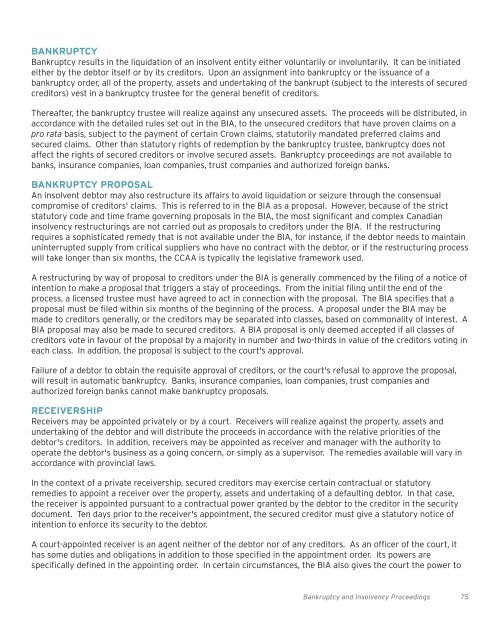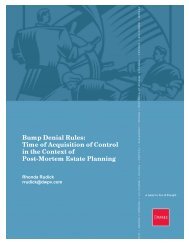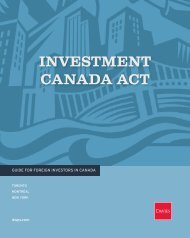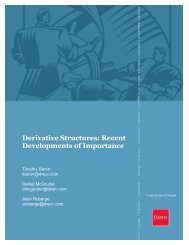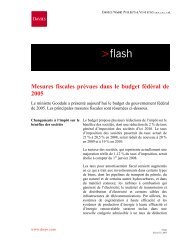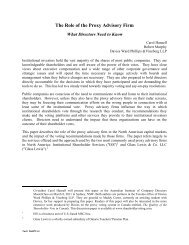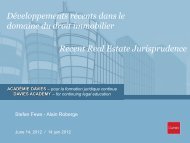doing business in canada - Davies Ward Phillips & Vineberg LLP
doing business in canada - Davies Ward Phillips & Vineberg LLP
doing business in canada - Davies Ward Phillips & Vineberg LLP
- No tags were found...
You also want an ePaper? Increase the reach of your titles
YUMPU automatically turns print PDFs into web optimized ePapers that Google loves.
BANKRUPTCYBankruptcy results <strong>in</strong> the liquidation of an <strong>in</strong>solvent entity either voluntarily or <strong>in</strong>voluntarily. It can be <strong>in</strong>itiatedeither by the debtor itself or by its creditors. Upon an assignment <strong>in</strong>to bankruptcy or the issuance of abankruptcy order, all of the property, assets and undertak<strong>in</strong>g of the bankrupt (subject to the <strong>in</strong>terests of securedcreditors) vest <strong>in</strong> a bankruptcy trustee for the general benefit of creditors.Thereafter, the bankruptcy trustee will realize aga<strong>in</strong>st any unsecured assets. The proceeds will be distributed, <strong>in</strong>accordance with the detailed rules set out <strong>in</strong> the BIA, to the unsecured creditors that have proven claims on apro rata basis, subject to the payment of certa<strong>in</strong> Crown claims, statutorily mandated preferred claims andsecured claims. Other than statutory rights of redemption by the bankruptcy trustee, bankruptcy does notaffect the rights of secured creditors or <strong>in</strong>volve secured assets. Bankruptcy proceed<strong>in</strong>gs are not available tobanks, <strong>in</strong>surance companies, loan companies, trust companies and authorized foreign banks.BANKRUPTCY PROPOSALAn <strong>in</strong>solvent debtor may also restructure its affairs to avoid liquidation or seizure through the consensualcompromise of creditors' claims. This is referred to <strong>in</strong> the BIA as a proposal. However, because of the strictstatutory code and time frame govern<strong>in</strong>g proposals <strong>in</strong> the BIA, the most significant and complex Canadian<strong>in</strong>solvency restructur<strong>in</strong>gs are not carried out as proposals to creditors under the BIA. If the restructur<strong>in</strong>grequires a sophisticated remedy that is not available under the BIA, for <strong>in</strong>stance, if the debtor needs to ma<strong>in</strong>ta<strong>in</strong>un<strong>in</strong>terrupted supply from critical suppliers who have no contract with the debtor, or if the restructur<strong>in</strong>g processwill take longer than six months, the CCAA is typically the legislative framework used.A restructur<strong>in</strong>g by way of proposal to creditors under the BIA is generally commenced by the fil<strong>in</strong>g of a notice of<strong>in</strong>tention to make a proposal that triggers a stay of proceed<strong>in</strong>gs. From the <strong>in</strong>itial fil<strong>in</strong>g until the end of theprocess, a licensed trustee must have agreed to act <strong>in</strong> connection with the proposal. The BIA specifies that aproposal must be filed with<strong>in</strong> six months of the beg<strong>in</strong>n<strong>in</strong>g of the process. A proposal under the BIA may bemade to creditors generally, or the creditors may be separated <strong>in</strong>to classes, based on commonality of <strong>in</strong>terest. ABIA proposal may also be made to secured creditors. A BIA proposal is only deemed accepted if all classes ofcreditors vote <strong>in</strong> favour of the proposal by a majority <strong>in</strong> number and two-thirds <strong>in</strong> value of the creditors vot<strong>in</strong>g <strong>in</strong>each class. In addition, the proposal is subject to the court's approval.Failure of a debtor to obta<strong>in</strong> the requisite approval of creditors, or the court's refusal to approve the proposal,will result <strong>in</strong> automatic bankruptcy. Banks, <strong>in</strong>surance companies, loan companies, trust companies andauthorized foreign banks cannot make bankruptcy proposals.RECEIVERSHIPReceivers may be appo<strong>in</strong>ted privately or by a court. Receivers will realize aga<strong>in</strong>st the property, assets andundertak<strong>in</strong>g of the debtor and will distribute the proceeds <strong>in</strong> accordance with the relative priorities of thedebtor's creditors. In addition, receivers may be appo<strong>in</strong>ted as receiver and manager with the authority tooperate the debtor's <strong>bus<strong>in</strong>ess</strong> as a go<strong>in</strong>g concern, or simply as a supervisor. The remedies available will vary <strong>in</strong>accordance with prov<strong>in</strong>cial laws.In the context of a private receivership, secured creditors may exercise certa<strong>in</strong> contractual or statutoryremedies to appo<strong>in</strong>t a receiver over the property, assets and undertak<strong>in</strong>g of a default<strong>in</strong>g debtor. In that case,the receiver is appo<strong>in</strong>ted pursuant to a contractual power granted by the debtor to the creditor <strong>in</strong> the securitydocument. Ten days prior to the receiver's appo<strong>in</strong>tment, the secured creditor must give a statutory notice of<strong>in</strong>tention to enforce its security to the debtor.A court-appo<strong>in</strong>ted receiver is an agent neither of the debtor nor of any creditors. As an officer of the court, ithas some duties and obligations <strong>in</strong> addition to those specified <strong>in</strong> the appo<strong>in</strong>tment order. Its powers arespecifically def<strong>in</strong>ed <strong>in</strong> the appo<strong>in</strong>t<strong>in</strong>g order. In certa<strong>in</strong> circumstances, the BIA also gives the court the power toBankruptcy and Insolvency Proceed<strong>in</strong>gs 75


